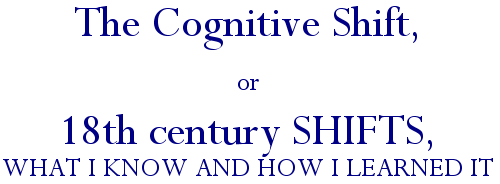
© Sharon Ann Burnston 2005, 2010, 2012, 2013, 2017, 2018

 INTRODUCTION We all wear shifts. If you are female and reenact the 18th c., chances are you've made at least one shift. Like every other reenactress, I began with a cotton shift that had a drawstring neck with "self-ruffle", and too-long sleeves ditto. That was in 1974. As we in the hobby began to take a more rigorous look at what we wore, and at what our 18th c. forebears wore, we began to improve many other things, however shift patterns didn't change much. What little research I could find in print on shifts (Cunnington & Cunnington) told me that my sleeves needed to be wider and shorter, but it wasn't until I had the opportunity to examine original garments that I began to realize that our understanding of the 18th c. shift needed some shifting of its own. For one thing, I realized that most of the museum objects and commercial patterns I was seeing seemed to be dated a bit earlier than they should be. In other words, objects and patterns described as "second half, 18th c." or "c 1770-1800" actually belonged to a later date than that. And the ones labeled "1780-1800" were probably post-1800. In preindustrial times, when the fashionable outer garment was rarely washable, and bodies rarely saw a bathtub either, it was the shift which kept the sweat and body oils from ruining the gown, while simultaneously protecting the body from the dyes and metal salts which "weighted" the gown fabrics. Therefore a shift had to cover at least as much of the body as the gown did, in order to do that job. The short-sleeved shifts I was seeing labeled as c 1780's were highly unlikely to be that early, as they couldn't serve their proper function, being too short for the sleeves of that decade's gowns. (cf. The Dress of the People, pp. 78-79) But shift research remained neglected territory. Our knowledge of 18th c. garments comes from three general classes of sources: first, images such as portraits, caricatures and genre scenes; second, text sources such as newspaper ads, wills, account books and estate inventories; and third, actual surviving garments. For studying gowns, shoes, or most other garments, a fair number of each of these classes of sources makes the research not all that difficult. Sadly this is not the case for shifts. Art works generally give us no more than tantalizing glimpses of the edges of shifts (if that), documents mention them only in passing, while surviving garments are very few, and nearly all of those are late, from the end of the century. There is just one 18th c. English-language sewing "instruction manual" I know of that discusses shifts, it dates from 1789, and all it contains are some brief cryptic directions for how to cut out shifts in quantity. So in my visits to examine objects in museum collections, I made a concerted effort to study all the shifts I could find, including ones that seemed to fall outside the dates of my primary interest. Eventually I even acquired a small but diverse collection of my own, of American shifts which range in date from 1752 to roughly 1840. Over the past twelve years I have been gradually developing an understanding of 18th c. shifts, how they were made and how they changed stylistically through the course of the century. In the process I have learned a great deal about how these original shifts were constructed. So of course I have been asked to teach workshops and classes on shift making. This article will be both a summary of what I teach in my shift making classes and an attempt to summarize what I have developed as my model for dating 18th c. shifts. It sums up the essentials of what I have learned about 18th c. American shifts since I began my efforts to study and understand them, about twelve years ago, in 1999 or 2000. I haven't felt that I knew enough yet to "publish", but clearly this information needs to be shared. Also, since I have already taught a few workshops, it occurred to me that some of this information might already be disseminating orally, with inevitable errors creeping in. Therefore, even though I feel my research to be unfinished, I realized it was better to present it myself, here. I regard this as a work in progress, and I hope to add to or amend this article as I can. So if you are interested in this subject, I encourage you to check back here once in awhile for any updates. ~~Sharon Ann Burnston April 1, 2012 Terms of Use: The patterns and diagrams in this article are for personal use only, all other rights are reserved. To put it another way, the article posted here is the distillation of twelve years' worth of research. By putting it on the Web, I am giving it to you for free. But that doesn't mean it has no value to me! What I ask of you in return is credit for my twelve years' work. No part of this article may be reproduced without permission. The patterns may not be reproduced for sale under any circumstances. You may use this information and these patterns in replicating 18th c. shifts for your own use, but not for commercial resale. In any use of this article or of any of the information contained in it, this author and this article must be properly cited, every single time, as the source of your information. THE INSTRUCTIONS Introduction Choosing Suitable Materials Cut and Construction Patterns You Can Use How to Fit a Shift to Your Body Shift Neckline Woes Sewing the Shift Stroke Gathers Ruffles Monogramming A Shift FAQs Replica Shift BIBLIOGRAPHY
 Home Website Copyright © 2002 - 2022 by Sharon Ann Burnston Web site designed by Sandy Cheney |